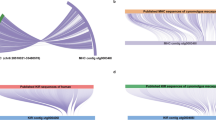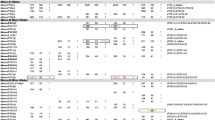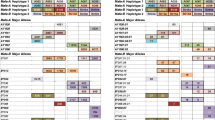Abstract
Killer cell immunoglobulin-like receptors (KIRs) modulate disease progression of pathogens including HIV, malaria, and hepatitis C. Cynomolgus and rhesus macaques are widely used as nonhuman primate models to study human pathogens, and so, considerable effort has been put into characterizing their KIR genetics. However, previous studies have relied on cDNA cloning and Sanger sequencing that lack the throughput of current sequencing platforms. In this study, we present a high throughput, full-length allele discovery method utilizing Pacific Biosciences circular consensus sequencing (CCS). We also describe a new approach to Macaque Exome Sequencing (MES) and the development of the Rhexome1.0, an adapted target capture reagent that includes macaque-specific capture probe sets. By using sequence reads generated by whole genome sequencing (WGS) and MES to inform primer design, we were able to increase the sensitivity of KIR allele discovery. We demonstrate this increased sensitivity by defining nine novel alleles within a cohort of Mauritian cynomolgus macaques (MCM), a geographically isolated population with restricted KIR genetics that was thought to be completely characterized. Finally, we describe an approach to genotyping KIRs directly from sequence reads generated using WGS/MES reads. The findings presented here expand our understanding of KIR genetics in MCM by associating new genes with all eight KIR haplotypes and demonstrating the existence of at least one KIR3DS gene associated with every haplotype.




Similar content being viewed by others
References
Albrecht C, Malzahn D, Brameier M, Hermes M, Ansari AA, Walter L (2014) Progression to AIDS in SIV-infected rhesus macaques is associated with distinct KIR and MHC class I polymorphisms and NK cell dysfunction. Front Immunol 5:600
Alter G, Martin MP, Teigen N, Carr WH, Suscovich TJ, Schneidewind A, Streeck H, Waring M, Meier A, Brander C, Lifson JD, Allen TM, Carrington M, Altfeld M (2007) Differential natural killer cell-mediated inhibition of HIV-1 replication based on distinct KIR/HLA subtypes. J Exp Med 204:3027–3036
Anderson DJ, Kirk AD (2013) Primate models in organ transplantation. Cold Spring Harb Perspect Med 3:a015503
Antony JM, MacDonald KS (2015) A critical analysis of the cynomolgus macaque, Macaca fascicularis, as a model to test HIV-1/SIV vaccine efficacy. Vaccine 33:3073–3083
Bainbridge MN, Wang M, Wu Y, Newsham I, Muzny DM, Jefferies JL, Albert TJ, Burgess DL, Gibbs RA (2011) Targeted enrichment beyond the consensus coding DNA sequence exome reveals exons with higher variant densities. Genome Biol 12:R68
Biassoni R, Falco M, Cambiaggi A, Costa P, Verdiani S, Pende D, Conte R, Di Donato C, Parham P, Moretta L (1995) Amino acid substitutions can influence the natural killer (NK)-mediated recognition of HLA-C molecules. Role of serine-77 and lysine-80 in the target cell protection from lysis mediated by “group 2” or “group 1” NK clones. J Exp Med 182:605–609
Bimber BN, Evans DT (2015) The killer-cell immunoglobulin-like receptors of macaques. Immunol Rev 267:246–258
Bimber BN, Moreland AJ, Wiseman RW, Hughes AL, O’Connor DH (2008) Complete characterization of killer Ig-like receptor (KIR) haplotypes in Mauritian cynomolgus macaques: novel insights into nonhuman primate KIR gene content and organization. J Immunol 181:6301–6308
Blokhuis JH, Doxiadis GG, Bontrop RE (2009) A splice site mutation converts an inhibitory killer cell Ig-like receptor into an activating one. Mol Immunol 46:640–648
Blokhuis JH, van der Wiel MK, Doxiadis GG, Bontrop RE (2010) The mosaic of KIR haplotypes in rhesus macaques. Immunogenetics 62:295–306
Blokhuis JH, van der Wiel MK, Doxiadis GG, Bontrop RE (2011) The extreme plasticity of killer cell Ig-like receptor (KIR) haplotypes differentiates rhesus macaques from humans. Eur J Immunol 41:2719–2728
Bonagura VR, Du Z, Ashouri E, Luo L, Hatam LJ, DeVoti JA, Rosenthal DW, Steinberg BM, Abramson AL, Gjertson DW, Reed EF, Rajalingam R (2010) Activating killer cell immunoglobulin-like receptors 3DS1 and 2DS1 protect against developing the severe form of recurrent respiratory papillomatosis. Hum Immunol 71:212–219
Carr WH, Pando MJ, Parham P (2005) KIR3DL1 polymorphisms that affect NK cell inhibition by HLA-Bw4 ligand. J Immunol 175:5222–5229
Carrillo-Bustamante P, Keşmir C, de Boer RJ (2016) The evolution of natural killer cell receptors. Immunogenetics 68:3–18
Carrington M, Norman P. (2003) The KIR Gene Cluster
Chaichompoo P, Bostik P, Stephenson S, Udompunturuk S, Kobkitjaroen J, Pattanapanyasat K, Ansari AA (2010) Multiple KIR gene polymorphisms are associated with plasma viral loads in SIV-infected rhesus macaques. Cell Immunol 263:176–187
Cirocco RE, Mathew JM, Burke GW, Esquenazi V, Miller J (2007) Killer cell immunoglobulin-like receptor polymorphisms in HLA-identical kidney transplant recipients: lack of 2DL2 and 2DS2 may be associated with poor graft function. Tissue Antigens 69(Suppl 1):123–124
Dunphy SE, Guinan KJ, Chorcora CN, Jayaraman J, Traherne JA, Trowsdale J, Pende D, Middleton D, Gardiner CM (2015) 2DL1, 2DL2 and 2DL3 all contribute to KIR phenotype variability on human NK cells. Genes Immun 16:301–310
Edgar RC (2010) Search and clustering orders of magnitude faster than BLAST. Bioinformatics 26:2460–2461
Eid J, Fehr A, Gray J, Luong K, Lyle J, Otto G, Peluso P, Rank D, Baybayan P, Bettman B, Bibillo A, Bjornson K, Chaudhuri B, Christians F, Cicero R, Clark S, Dalal R, Dewinter A, Dixon J, Foquet M, Gaertner A, Hardenbol P, Heiner C, Hester K, Holden D, Kearns G, Kong X, Kuse R, Lacroix Y, Lin S, Lundquist P, Ma C, Marks P, Maxham M, Murphy D, Park I, Pham T, Phillips M, Roy J, Sebra R, Shen G, Sorenson J, Tomaney A, Travers K, Trulson M, Vieceli J, Wegener J, Wu D, Yang A, Zaccarin D, Zhao P, Zhong F, Korlach J, Turner S (2009) Real-time DNA sequencing from single polymerase molecules. Science 323:133–138
Ericsen AJ, Starrett GJ, Greene JM, Lauck M, Raveendran M, Deiros DR, Mohns MS, Vince N, Cain BT, Pham NH, Weinfurter JT, Bailey AL, Budde ML, Wiseman RW, Gibbs R, Muzny D, Friedrich TC, Rogers J, O’Connor DH (2014) Whole genome sequencing of SIV-infected macaques identifies candidate loci that may contribute to host control of virus replication. Genome Biol 15:478
Felsenstein J (1985) Confidence limits on phylogenies: an approach using the bootstrap. Evolution 39:783–791
Gardiner CM (2008) Killer cell immunoglobulin-like receptors on NK cells: the how, where and why. Int J Immunogenet 35:1–8
González-Galarza FF, Takeshita LY, Santos EJ, Kempson F, Maia MH, da Silva AL, Silva ALT e, Ghattaoraya GS, Alfirevic A, Jones AR, Middleton D (2015) Allele frequency net 2015 update: new features for HLA epitopes, KIR and disease and HLA adverse drug reaction associations. Nucleic Acids Res 43:D784–D788
Hansen DS, D’Ombrain MC, Schofield L (2007) The role of leukocytes bearing natural killer complex receptors and killer immunoglobulin-like receptors in the immunology of malaria. Curr Opin Immunol 19:416–423
Hellmann I, Lim SY, Gelman RS, Letvin NL (2011) Association of activating KIR copy number variation of NK cells with containment of SIV replication in rhesus monkeys. PLoS Pathog 7:e1002436
Hellmann I, Letvin NL, Schmitz JE (2013) KIR2DL4 copy number variation is associated with CD4+ T-cell depletion and function of cytokine-producing NK cell subsets in SIV-infected Mamu-A*01-negative rhesus macaques. J Virol 87:5305–5310
Hershberger KL, Shyam R, Miura A, Letvin NL (2001) Diversity of the killer cell Ig-like receptors of rhesus monkeys. J Immunol 166:4380–4390
Hershberger KL, Kurian J, Korber BT, Letvin NL (2005) Killer cell immunoglobulin-like receptors (KIR) of the African-origin sabaeus monkey: evidence for recombination events in the evolution of KIR. Eur J Immunol 35:922–935
Hilton HG, Guethlein LA, Goyos A, Nemat-Gorgani N, Bushnell DA, Norman PJ, Parham P (2015) Polymorphic HLA-C receptors balance the functional characteristics of KIR haplotypes. J Immunol 195:3160–3170
Jiang Y, Chen O, Cui C, Zhao B, Han X, Zhang Z, Liu J, Xu J, Hu Q, Liao C, Shang H (2013) KIR3DS1/L1 and HLA-Bw4-80I are associated with HIV disease progression among HIV typical progressors and long-term nonprogressors. BMC Infect Dis 13:405
Jones DT, Taylor WR, Thornton JM (1992) The rapid generation of mutation data matrices from protein sequences. Comput Appl Biosci 8:275–282
Karl JA, Graham ME, Wiseman RW, Heimbruch KE, Gieger SM, Doxiadis GG, Bontrop RE, O’Connor DH (2017) Major histocompatibility complex haplotyping and long-amplicon allele discovery in cynomolgus macaques from Chinese breeding facilities. Immunogenetics 69:211–229
Kearse M, Moir R, Wilson A, Stones-Havas S, Cheung M, Sturrock S, Buxton S, Cooper A, Markowitz S, Duran C, Thierer T, Ashton B, Meintjes P, Drummond A (2012) Geneious Basic: an integrated and extendable desktop software platform for the organization and analysis of sequence data. Bioinformatics 28:1647–1649
Khakoo SI, Thio CL, Martin MP, Brooks CR, Gao X, Astemborski J, Cheng J, Goedert JJ, Vlahov D, Hilgartner M, Cox S, Little AM, Alexander GJ, Cramp ME, O’Brien SJ, Rosenberg WM, Thomas DL, Carrington M (2004) HLA and NK cell inhibitory receptor genes in resolving hepatitis C virus infection. Science 305:872–874
Knapp S, Warshow U, Hegazy D, Brackenbury L, Guha IN, Fowell A, Little AM, Alexander GJ, Rosenberg WM, Cramp ME, Khakoo SI (2010) Consistent beneficial effects of killer cell immunoglobulin-like receptor 2DL3 and group 1 human leukocyte antigen-C following exposure to hepatitis C virus. Hepatology 51:1168–1175
Kochetov AV (2008) Alternative translation start sites and hidden coding potential of eukaryotic mRNAs. BioEssays 30:683–691
Kruse PH, Rosner C, Walter L (2010) Characterization of rhesus macaque KIR genotypes and haplotypes. Immunogenetics 62:281–293
Kumar S, Stecher G, Tamura K (2016) MEGA7: Molecular Evolutionary Genetics Analysis version 7.0 for bigger datasets. Mol Biol Evol 33:1870–1874
Kunert K, Seiler M, Mashreghi MF, Klippert K, Schönemann C, Neumann K, Pratschke J, Reinke P, Volk HD, Kotsch K (2007) KIR/HLA ligand incompatibility in kidney transplantation. Transplantation 84:1527–1533
Kuśnierczyk P (2013) Are killer cell immunoglobulin-like receptor genes important for the prediction of kidney graft rejection. Arch Immunol Ther Exp 61:321–325
La Manna G, Corsini S, Iannelli S, Cappuccilli ML, Comai G, Iorio M, Todeschini P, Carretta E, Scolari MP, Bontadini A, Stefoni S (2013) Influence of the immunogenetic KIR and HLA systems on long-term renal transplant outcome. Ann Transplant 18:611–621
Lanier LL (2005) NK cell recognition. Annu Rev Immunol 23:225–274
Larkin MA, Blackshields G, Brown NP, Chenna R, McGettigan PA, McWilliam H, Valentin F, Wallace IM, Wilm A, Lopez R, Thompson JD, Gibson TJ, Higgins DG (2007) Clustal W and Clustal X version 2.0. Bioinformatics 23:2947–2948
Legaz I, López-Álvarez MR, Campillo JA, Moya-Quiles MR, Bolarín JM, de la Peña J, Salgado G, Gimeno L, García-Alonso AM, Muro M, Miras M, Alonso C, Álvarez-López MR, Minguela A (2013) KIR gene mismatching and KIR/C ligands in liver transplantation: consequences for short-term liver allograft injury. Transplantation 95:1037–1044
Lodoen MB, Lanier LL (2006) Natural killer cells as an initial defense against pathogens. Curr Opin Immunol 18:391–398
Long EO, Rajagopalan S (2000) HLA class I recognition by killer cell Ig-like receptors. Semin Immunol 12:101–108
Lupski JR, Gonzaga-Jauregui C, Yang Y, Bainbridge MN, Jhangiani S, Buhay CJ, Kovar CL, Wang M, Hawes AC, Reid JG, Eng C, Muzny DM, Gibbs RA (2013) Exome sequencing resolves apparent incidental findings and reveals further complexity of SH3TC2 variant alleles causing Charcot-Marie-Tooth neuropathy. Genome Med 5:57
Marras F, Bozzano F, Ascierto ML, De Maria A (2014) Baseline and dynamic expression of activating NK cell receptors in the control of chronic viral infections: the paradigm of HIV-1 and HCV. Front Immunol 5. doi:10.3389/fimmu.2014.00305
Martin MP, Gao X, Lee JH, Nelson GW, Detels R, Goedert JJ, Buchbinder S, Hoots K, Vlahov D, Trowsdale J, Wilson M, O’Brien SJ, Carrington M (2002) Epistatic interaction between KIR3DS1 and HLA-B delays the progression to AIDS. Nat Genet 31:429–434
Messaoudi I, Estep R, Robinson B, Wong SW (2011) Nonhuman primate models of human immunology. Antioxid Redox Signal 14:261–273
Middleton D, Gonzelez F (2010) The extensive polymorphism of KIR genes. Immunology 129:8–19
Moreland AJ, Guethlein LA, Reeves RK, Broman KW, Johnson RP, Parham P, O’Connor DH, Bimber BN (2011) Characterization of killer immunoglobulin-like receptor genetics and comprehensive genotyping by pyrosequencing in rhesus macaques. BMC Genomics 12:295
Ponte M, Cantoni C, Biassoni R, Tradori-Cappai A, Bentivoglio G, Vitale C, Bertone S, Moretta A, Moretta L, Mingari MC (1999) Inhibitory receptors sensing HLA-G1 molecules in pregnancy: decidua-associated natural killer cells express LIR-1 and CD94/NKG2A and acquire p49, an HLA-G1-specific receptor. Proc Natl Acad Sci U S A 96:5674–5679
Quinlan AR, Hall IM (2010) BEDTools: a flexible suite of utilities for comparing genomic features. Bioinformatics 26:841–842
Rice P, Longden I, Bleasby A (2000) EMBOSS: the European molecular biology open software suite. Trends Genet 16:276–277
Robinson J, Waller MJ, Stoehr P, Marsh SG (2005) IPD—the immuno polymorphism database. Nucleic Acids Res 33:D523–D526
Saitou N, Nei M (1987) The neighbor-joining method: a new method for reconstructing phylogenetic trees. Mol Biol Evol 4:406–425
Sambrook JG, Bashirova A, Palmer S, Sims S, Trowsdale J, Abi-Rached L, Parham P, Carrington M, Beck S (2005) Single haplotype analysis demonstrates rapid evolution of the killer immunoglobulin-like receptor (KIR) loci in primates. Genome Res 15:25–35
Sambrook JG, Bashirova A, Andersen H, Piatak M, Vernikos GS, Coggill P, Lifson JD, Carrington M, Beck S (2006) Identification of the ancestral killer immunoglobulin-like receptor gene in primates. BMC Genomics 7:209
Schmitz JE, Korioth-Schmitz B (2013) Immunopathogenesis of simian immunodeficiency virus infection in nonhuman primates. Curr Opin HIV AIDS 8:273–279
Shilling HG, Young N, Guethlein LA, Cheng NW, Gardiner CM, Tyan D, Parham P (2002) Genetic control of human NK cell repertoire. J Immunol 169:239–247
Sussman RW, Tattersall I (1986) Distribution, abundance, and putative ecological strategy of Macaca fascicularis on the island of Mauritius, southwestern Indian Ocean. Folia Primatol 46:28–43
Travers KJ, Chin CS, Rank DR, Eid JS, Turner SW (2010) A flexible and efficient template format for circular consensus sequencing and SNP detection. Nucleic Acids Res 38:e159
Trowsdale J, Barten R, Haude A, Stewart CA, Beck S, Wilson MJ (2001) The genomic context of natural killer receptor extended gene families. Immunol Rev 181:20–38
Uhrberg M, Valiante NM, Shum BP, Shilling HG, Lienert-Weidenbach K, Corliss B, Tyan D, Lanier LL, Parham P (1997) Human diversity in killer cell inhibitory receptor genes. Immunity 7:753–763
Valiante NM, Uhrberg M, Shilling HG, Lienert-Weidenbach K, Arnett KL, D’Andrea A, Phillips JH, Lanier LL, Parham P (1997) Functionally and structurally distinct NK cell receptor repertoires in the peripheral blood of two human donors. Immunity 7:739–751
Vallender EJ (2011) Expanding whole exome resequencing into non-human primates. Genome Biol 12:R87
Van Bergen J, Thompson A, Haasnoot GW, Roodnat JI, de Fijter JW, Claas FH, Koning F, Doxiadis II (2011) KIR-ligand mismatches are associated with reduced long-term graft survival in HLA-compatible kidney transplantation. Am J Transplant 11:1959–1964
Wende H, Volz A, Ziegler A (2000) Extensive gene duplications and a large inversion characterize the human leukocyte receptor cluster. Immunogenetics 51:703–713
Westbrook CJ, Karl JA, Wiseman RW, Mate S, Koroleva G, Garcia K, Sanchez-Lockhart M, O’Connor DH, Palacios G (2015) No assembly required: full-length MHC class I allele discovery by PacBio circular consensus sequencing. Hum Immunol 76:891–896
Wilson MJ, Torkar M, Haude A, Milne S, Jones T, Sheer D, Beck S, Trowsdale J (2000) Plasticity in the organization and sequences of human KIR/ILT gene families. Proc Natl Acad Sci U S A 97:4778–4783
Wiseman RW, Karl JA, Bimber BN, O’Leary CE, Lank SM, Tuscher JJ, Detmer AM, Bouffard P, Levenkova N, Turcotte CL, Szekeres E, Wright C, Harkins T, O’Connor DH (2009) Major histocompatibility complex genotyping with massively parallel pyrosequencing. Nat Med 15:1322–1326
Wiseman RW, Karl JA, Bohn PS, Nimityongskul FA, Starrett GJ, O’Connor DH (2013) Haplessly hoping: macaque major histocompatibility complex made easy. ILAR J 54:196–210
Yan WH, Lin A, Chen BG, Zhou MY, Dai MZ, Chen XJ, Gan LH, Zhu M, Shi WW, Li BL (2007) Possible roles of KIR2DL4 expression on uNK cells in human pregnancy. Am J Reprod Immunol 57:233–242
Yawata M, Yawata N, Draghi M, Little AM, Partheniou F, Parham P (2006) Roles for HLA and KIR polymorphisms in natural killer cell repertoire selection and modulation of effector function. J Exp Med 203:633–645
Zipperlen K, Gallant M, Stapleton S, Heath J, Barrett L, Grant M (2015) Protective genotypes in HIV infection reflect superior function of KIR3DS1+ over KIR3DL1+ CD8+ T cells. Immunol Cell Biol 93:67–76
Acknowledgements
This research was supported by contracts HHSN272201600007C and HHSN272201100013C from the National Institute of Allergy and Infectious Diseases of the National Institutes of Health and was conducted at a facility constructed with support from the Research Facilities Improvement Program (RR15459-01, RR20141-01).
Author information
Authors and Affiliations
Corresponding author
Electronic supplementary material
Supplementary Fig. 1
Mafa-KIR3DL and Mafa -KIR3DS phylogenetic trees. Phylogenetic analysis of MCM KIR3DL and KIR3DS sequences. Both phylogenetic trees contain the human KIR3DL1*00701 allele as an outgroup (AF262973). Bootstrapping values are shown to the left of nodes. Novel sequences are highlighted in bold font. A, the tree contains KIR3DL sequences. Vertical bars denote lineages. B, the tree contains KIR3DS sequences. (PDF 61 kb).
Supplementary Table 1
(DOCX 62 kb).
Supplementary Table 2
(DOCX 89 kb).
Supplementary Table 3
(DOCX 40 kb).
Supplementary Table 4
(DOCX 35 kb).
Supplementary Table 5
(DOCX 17 kb).
Supplementary Table 6
Comparison of sequences identified by PacBio CCS versus WGS/MES. (DOCX 84 kb).
Rights and permissions
About this article
Cite this article
Prall, T.M., Graham, M.E., Karl, J.A. et al. Improved full-length killer cell immunoglobulin-like receptor transcript discovery in Mauritian cynomolgus macaques. Immunogenetics 69, 325–339 (2017). https://doi.org/10.1007/s00251-017-0977-7
Received:
Accepted:
Published:
Issue Date:
DOI: https://doi.org/10.1007/s00251-017-0977-7




